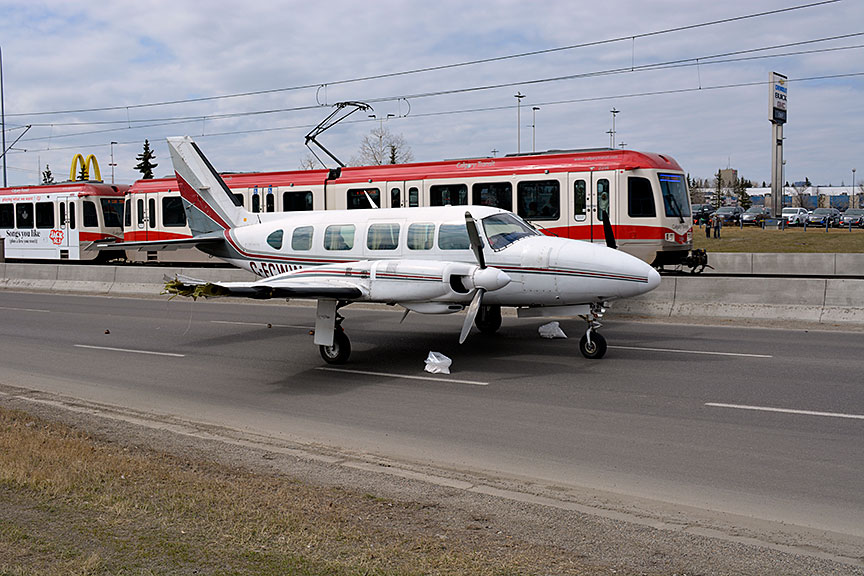Engine power loss and forced landing
Super T Aviation
Piper PA-31-350 Navajo Chieftain, C-FCWW
Calgary, Alberta
The occurrence
On , a small Piper Navajo PA-31-350, aircraft, operated by Super T Aviation Academy, made an emergency landing on a city street of Calgary shortly before 6 am local time. With two pilots and four passengers on board, the aircraft was conducting a flight from Medicine Hat, Alberta to Calgary, Alberta.
After receiving permission to land at the Calgary International Airport, the crew observed that the right fuel boost pump light was on. Soon after, both engines began to surge and no longer produced sufficient power to maintain altitude. Unable to reach the nearest runway, the crew conducted a forced landing onto 36th Street NE, 2.8 nautical miles south of the threshold of Runway 35R. Shortly after touchdown, the aircraft's outer right wing struck a pole near the Trans-Canada Highway and lost approximately four feet of wing. The left propeller made contact with a concrete structure, which damaged the tips of the three propeller blades.
There were no injuries to the aircraft occupants or persons on the ground.
Media materials
News release
Investigation report: April 2018 engine power loss and forced landing in Calgary, Alberta
Read the news release
Deployment notice
TSB deploys a team of investigators to Calgary, Alberta, following an emergency landing on 36th Street
Edmonton, Alberta, 25 April 2018 - The Transportation Safety Board of Canada (TSB) is deploying a team of investigators following an emergency landing incident involving a Piper PA 31 that occurred in Calgary, Alberta. The TSB will gather information and assess the occurrence.
Investigation information
Download high-resolution photos from the TSB Flickr page.
Class of investigation
This is a class 4 investigation. These investigations are limited in scope, and while the final reports may contain limited analysis, they do not contain findings or recommendations. Class 4 investigations are generally completed within 220 days. For more information, see the Policy on Occurrence Classification.
TSB investigation process
There are 3 phases to a TSB investigation
- Field phase: a team of investigators examines the occurrence site and wreckage, interviews witnesses and collects pertinent information.
- Examination and analysis phase: the TSB reviews pertinent records, tests components of the wreckage in the lab, determines the sequence of events and identifies safety deficiencies. When safety deficiencies are suspected or confirmed, the TSB advises the appropriate authority without waiting until publication of the final report.
- Report phase: a confidential draft report is approved by the Board and sent to persons and corporations who are directly concerned by the report. They then have the opportunity to dispute or correct information they believe to be incorrect. The Board considers all representations before approving the final report, which is subsequently released to the public.
For more information, see our Investigation process page.
The TSB is an independent agency that investigates air, marine, pipeline, and rail transportation occurrences. Its sole aim is the advancement of transportation safety. It is not the function of the Board to assign fault or determine civil or criminal liability.
